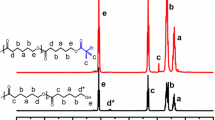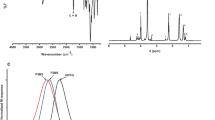Abstract
A novelty approach to self-assembling stereocomplex micelles by enantiomeric PLA–PEG block copolymers as a drug delivery carrier was described. The particles were encapsulated by enantiomeric PLA–PEG stereocomplex to form nanoscale micelles different from the microspheres or the single micelles by PLLA or PDLA in the reported literatures. First, the block copolymers of enantiomeric poly(l-lactide)–poly(ethylene–glycol) (PLLA–PEG) and poly(D-lactide)–poly(ethylene–glycol) (PDLA–PEG) were synthesized by the ring-opening polymerization of l-lactide and d-lactide in the presence of monomethoxy PEG, respectively. Second, the stereocomplex block copolymer micelles were obtained by the self-assembly of the equimolar mixtures of enantiomeric PLA–PEG copolymers in water. These micelles possessed partially the crystallized hydrophobic cores with the critical micelle concentrations (cmc) in the range of 0.8–4.8 mg/l and the mean hydrodynamic diameters ranging from 40 to 120 nm. The micelle sizes and cmc values obviously depended on the hydrophobic block PLA content in the copolymer. Compared with the single PLLA–PEG or PDLA–PEG micelles, the cmc values of the stereocomplex micelles became lower and the sizes of the stereocomplex micelles formed smaller. And lastly, the stereocomplex micelles encapsulated with rifampin were tested for the controlled release application. The rifampin loading capacity and encapsulation efficiency by the stereocomplex micelles were higher than those by the single polymer micelles, respectively. The drug release time in vitro was depending on the composites of the block copolymers and also could be controlled by the polymer molecular weight and the morphology of the polymer micelles.
Similar content being viewed by others
References
Bishara A., H.R. Kricheldorf, A.J. Domb (2005). Stereocomplexes of triblock poly(lactide-PEG2000-lactide) as carrier of drugs. Macromol. Symp. 225, 17–30
Dai Z., L. Piao., X. Zhang, M. Deng, X. Chen, X. Jing (2004). Probing the micellization of diblock and triblock copolymers of poly(l-lactide) and poly(ethylene glycol) in aqueous and NaCl salt solutions. Colloid Polym. Sci. 282, 343–350
Gref R., Y. Minamitake, M.T. Peracchia, V. Trubetskoy, V. Torchilin & R. Langer, 1994. Biodegradable long-circulating polymeric nanospheres. Science 263, 1600–1603
Hagan S.A., Coombes A.G.A., Garnett M.C., Dunn S.E., Davies M.C., Illum L., Davis S.S., Harding S.E., Purkiss S., Gellert P.R. (1996). Polylactide–poly(ethylene glycol) copolymers as drug delivery systems. 1. Characterization of water dispersible micelle-forming Systems. Langmuir 12(9), 2153–2161
Harada A., Kataoka K. (1999). On-Off control of enzymatic activity synchronizing with reversible formation of supramolecular assembly from enzyme and charged block copolymers. J. Am. Chem. Soc. 121, 9241–9242
Hiemenz P.C., Rajagopalan R. (1997). Principles of Colloid and Surface Chemistry. 3rd edn. Marcel-Dekker, NY
Hu J., Tang Z., Qiu X., Pang X., Yang Y., Chen X., Jing X. (2005). Formation of flower- or cake-shaped stereocomplex particles from the stereo multiblock copoly(rac-lactide)s. Biomacromolecules 6(5), 2843–2850
Kada Y., Jamshidi K., Tsuji H., Hyon S.-H. (1987). Maltopentaose- and maltoheptaose-carrying styrene macromers and their homopolymers. Macromolecules 20, 906–908
Jeong B., Bae Y.H., Lee D.S., Kim S.W. (1997). Biodegradable block copolymers as injectable drug-delivery systems. Nature 388, 860–862
Kang N., Perron M.E., Prud’homme R.E., Y. Zhang, G. Gaucher, J.-C. Leroux, (2005). Stereocomplex block copolymer micelles: Core-shell nanostructures with enhanced stability. Nano Lett. 5(2), 315–319
Kataoka K., A. Harada, Y. Nagasaki (2001). Block copolymer micelles for drug delivery: Design, characterization and biological significance. Adv. Drug Deliver. Rev. 47, 113–131
Langer R. (2001). Drug delivery: Drugs on target. Science 293, 58–59
Li S., Vert M. (2003). Synthesis, characterization, and stereocomplex-induced gelation of block copolymers prepared by ring-opening polymerization of l(d)-Lactide in the presence of Poly(ethylene glycol). Macromolecules 36, 8008–8014
Lim D.W., T.G. Park (2000). Stereocomplex formation between enantiomeric PLA–PEG–PLA triblock copolymers: characterization and use as protein-delivery microparticulate carriers. J. Appl. Polym. Sci. 75, 1615–1623
Ning Kang, M.E. Perron, E. Pobert, Prudehomme, Yubao Zhang, Genevieve Gaucher, Jean-Chriscopher, Leroux, 2005. Nanoletters, 5(2), 315–319
Pang X., H. Du, X. Chen, X. Zhuang, D. Cui, X. Jing, 2005. Aluminum Schiff base catalysts derived from β-diketone for the stereoselective polymerization of racemic lactides. 98(1), 102–108
Rashkof I., Manolova N., Li S.M., Espartero J.L., Vert M. (1996). Synthesis, characterization, and hydrolytic degradation of PLA/PEO/PLA triblock copolymers with short Poly(l-lactic acid) Chains. Macromolecules 29, 50
Riley T., Stolnik S, Heald C.R., Xiong C.D., Garnett M.C., Hlum L., Davis S. (2001). Physicochemical evaluation of nanoparticles assembled from Poly(lactic acid)–poly(ethylene glycol) (PLA–PEG) block copolymers as drug delivery vehicles. Langmuir 17, 3168–3174
Savic R., Luo L., Eisenberg A., Maysinger D. (2003). Micellar nanocontainers distribute to defined cytoplasmic organelles. Science 300, 615–618
Shuai X., Merdan T., Unger F., Wittmar M., Kissel T. (2003). Novel biodegradable ternary copolymers hy-PEI-g-PCL-b-PEG: synthesis, characterization, and potential as efficient nonviral gene delivery vectors. Macromolecules 36, 5751–5759
Stager J., Domb A. (2003). Biopolymer stereocomplexes. J. Adv. Drug Deliv. Rev. 55, 549–583
Tang Z., Chen X., Pang X., Yang Y., Zhang X., Jing X. (2004). Stereoselective polymerization of rac-Lactide using a monoethylaluminum Schiff base complex. Biomacromolecules 5(3), 965–970
Tang Z., Chen X., Yang Y., Pang X., Sun J., Zhang X., Jing X. (2004). Stereoselective polymerization of rac-lactide with a bulky aluminum/Schiff base complex. J. Polym. Sci. Part A: Polym. Chem. 42(23), 5974–5982
Webb, M.S., T.O. Harasym, D. Masin, M.B. Bally & D. Mayer, 1995. Sphingomyelin-cholesterol liposomes significantly enhance the pharmacokinetic and therapeutic properties of vincristine in murine and human tumour models. Br. J. Pharmacol. 72, 896–904
Wilhelm M., C.L. Zhao, Y. Wang, R. Xu, M.A. Winnik, J.L. Mura, G. Riess, M.D. Croucher (1991). Poly(styrene–ethylene oxide) block copolymer micelle formation in water: A fluorescence probe study. Macromolecules 24(5), 1033–1040
Yokoyama M., S. Fukushima, R. Uehara, K. Okamoto, K. Kataoka, Y. Sakurai, T. Okano (1998). Characterization of physical entrapment and chemical conjugation of adriamycin in polymeric micelles and their design for in vivo delivery to a solid tumor. J. Control Release 50, 79–92
Yoon S.N., H.S. Kanga, J.Y. Park, T.G. Park, S-H. Han, I-S. Chang (2003). New micelle-like polymer aggregates made from PEI–PLGA diblock copolymers: micellar characteristics and cellular uptake. Biomaterials 24, 2053–2059
Youxin L., Kissel T. (1993). Synthesis and properties of biodegradable ABA triblock copolymers consisting of poly(l-lactic acid) or poly (l-lactic-co-glycolic acid) A-blocks attached to central poly (oxyethylene) B-blocks. J. Control. Release 27, 247–257
Acknowledgements
The authors are thankful to National Natural Science Foundation of China (No. 50273038, 50373043) and National Fund for Distinguished Young Scholar (No. 50425309). The authors thank Prof. Yuesheng Li for his helpful discussion. The authors are also thankful to the Natural Science Foundation for Young Teacher of Northeast Normal University (20050308).
Author information
Authors and Affiliations
Corresponding author
Rights and permissions
About this article
Cite this article
Chen, L., Xie, Z., Hu, J. et al. Enantiomeric PLA–PEG block copolymers and their stereocomplex micelles used as rifampin delivery. J Nanopart Res 9, 777–785 (2007). https://doi.org/10.1007/s11051-006-9103-8
Received:
Accepted:
Published:
Issue Date:
DOI: https://doi.org/10.1007/s11051-006-9103-8




